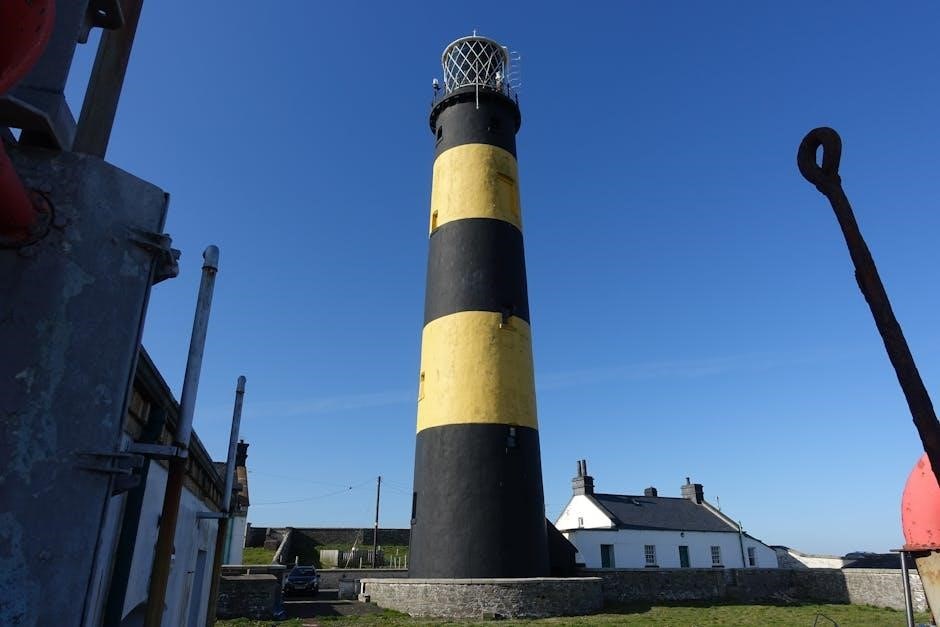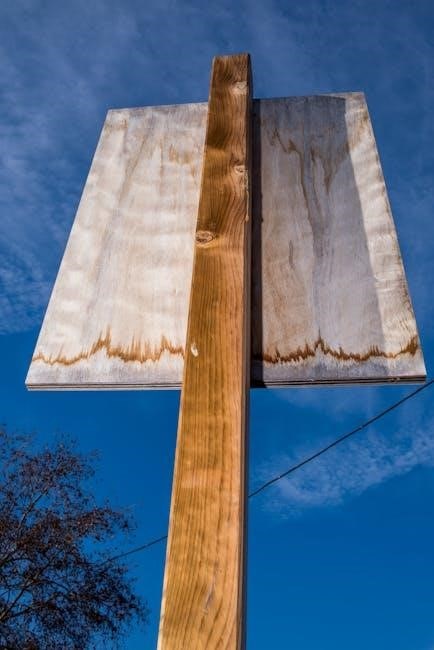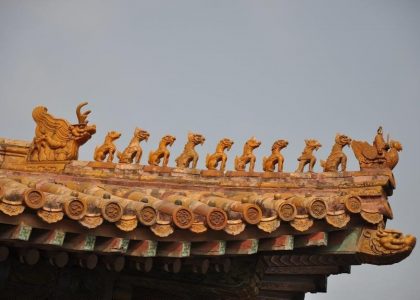Here’s the requested text:

Guide Pole: An Overview
A guide pole‚ often called a guy wire or stay‚ is a tensioned cable designed to stabilize freestanding structures. These poles are crucial for providing support and preventing collapse due to lateral forces such as wind.
Here’s the requested text:
Definition of a Guide Pole
A guide pole‚ more accurately known as a guy wire‚ guy line‚ or stay‚ is a crucial structural element. It’s specifically engineered to provide enhanced stability to freestanding structures. These structures can be anything from utility poles and radio masts to wind turbines and even tents. The primary function of a guy wire is to counteract lateral forces‚ such as wind load or the weight of attached equipment. This counteraction ensures the structure remains upright and stable‚ preventing it from leaning or collapsing.
The wire rope is affixed between the structure needing support and an anchor point on the ground. By applying tension‚ the wire provides resistance against external forces‚ maintaining structural integrity. The angle and placement of the guy wire are carefully calculated to optimize its effectiveness in providing support.
Here’s the requested text:
Common Names: Guy Wire‚ Guy Line‚ Stay
While “guide pole” is sometimes used‚ the more prevalent and accepted terms are “guy wire‚” “guy line‚” and “stay.” These terms all refer to the same component: a tensioned cable used to stabilize a structure. The term “guy wire” is perhaps the most common‚ particularly in the context of utility poles and radio masts. “Guy line” is frequently used when referring to temporary structures like tents‚ while “stay” has nautical origins‚ describing similar supporting cables on ship masts.
Regardless of the specific term‚ the function remains consistent. It’s important to understand these various names when discussing or working with these support systems. Using the correct terminology ensures clarity and prevents confusion‚ especially in technical or professional settings. Familiarity with these terms is essential for effective communication and accurate understanding.
Here’s the requested text:

Applications of Guide Poles
Guide poles‚ or guy wires‚ find extensive use in stabilizing various structures. Common applications include utility poles‚ radio masts‚ wind turbines‚ sailboat masts‚ and even temporary structures like tents‚ ensuring stability against external forces.
Here’s the requested text:
Utility Poles: Support and Stability
Utility poles rely on guide poles‚ or guy wires‚ for essential support and stability‚ particularly at points where wire lines end or change direction. These guy wires counteract the unbalanced lateral loads imposed by the attached utility wires. They are especially critical on dead-end or anchor poles‚ ensuring the pole remains upright against the constant pull. The installation process involves attaching the guy wire to the pole using a guy ring and clamp. The wire is then anchored firmly in the ground‚ ideally at a 45-degree angle‚ to maximize support and prevent the pole from leaning or falling. The hardware used must be durable to withstand constant tension and weather exposure. Without guide poles‚ utility poles would be vulnerable to toppling‚ especially during storms or high winds‚ disrupting essential services.
Here’s the requested text:
Radio and Antenna Masts
Radio and antenna masts frequently utilize guide poles‚ also known as guy wires‚ to maintain stability against wind and other environmental forces. These masts‚ often tall and slender‚ require significant support to prevent swaying or collapse. The guy wires are typically arranged radially‚ spaced equally around the mast‚ and anchored securely to the ground. The tension in these wires‚ combined with the mast’s compressive strength‚ ensures the structure can withstand lateral loads. Insulators are often integrated into the guy wires to prevent interference with radio frequencies. Proper design and installation of the guy wire system are essential for the safe and reliable operation of radio and antenna masts. Factors like wire material‚ tension‚ and anchor placement must be carefully considered to guarantee long-term structural integrity. The absence of effective guide poles can lead to catastrophic failure‚ disrupting communications and posing safety risks.
Here’s the requested text:
Sailboat Masts
Sailboat masts rely heavily on guide poles‚ referred to as standing rigging‚ for stability and support against the dynamic forces exerted by wind and waves. These guide poles‚ traditionally made of stainless steel wire rope‚ are essential for maintaining the mast’s vertical position and preventing it from bending or breaking under sail. Shrouds‚ which run from the mast to the sides of the boat (port and starboard)‚ and stays‚ which run fore and aft‚ act as the primary guide poles. Spreaders are often incorporated to keep the mast straight and in column. Temporary guide poles‚ like a fore-guy controlling the spinnaker pole‚ are also employed. The design and tension of these guide poles are critical for the sailboat’s performance and safety. Proper maintenance and inspection are crucial to prevent failures‚ which could lead to dismasting and potential hazards at sea. The strength and reliability of the guide poles directly impact the sailboat’s ability to withstand the rigors of sailing.
Here’s the requested text:
Wind Turbines
Wind turbines‚ especially larger models‚ frequently utilize guide poles as an additional measure of stability‚ although their primary support comes from a robust tower structure. In this context‚ guide poles‚ also known as guy wires or stays‚ provide supplemental resistance against extreme wind loads and potential structural imbalances. These tensioned cables are anchored to the ground at a distance from the turbine’s base and attached to the tower at strategic points. The guide poles help to distribute stress and prevent excessive swaying or tilting‚ particularly in areas prone to high winds or unstable soil conditions. While not always necessary for smaller turbines‚ guide poles are a crucial safety feature for larger installations‚ ensuring long-term structural integrity and minimizing the risk of catastrophic failure. Proper installation and regular inspection of these guide poles are essential for maintaining the safe and efficient operation of wind turbines.
Here’s the requested text:
Tents and Temporary Structures
Guide poles are indispensable for securing tents and various temporary structures‚ ensuring their stability against wind and other environmental factors. In this application‚ guide poles‚ often referred to as guy lines or guy ropes‚ are tensioned cables extending from the tent’s fabric or frame to ground anchors. These lines distribute the force of the wind‚ preventing the tent from collapsing or being blown away. The effectiveness of guide poles depends on their proper placement‚ tension‚ and the strength of the ground anchors. Different types of tents and temporary structures may require varying numbers and configurations of guide poles based on their size‚ shape‚ and intended use. Regular adjustment of the tension in the guide poles is essential to compensate for changes in weather conditions and maintain the structure’s stability. Reflective materials are often incorporated into guy lines to enhance visibility and prevent tripping hazards‚ especially in low-light conditions.
Here’s the requested text:

Components and Hardware
Guide poles rely on specific hardware for secure installation and effective functionality. This includes guy rings‚ clamps‚ strain insulators‚ anchors‚ and reflectors. Each component plays a vital role in maintaining stability and safety.
Here’s the requested text:
Guy Rings and Clamps
Guy rings and clamps are essential hardware components used in the installation of guide poles. These elements facilitate the secure attachment of guy wires to utility poles‚ towers‚ or masts. Guy rings are typically circular metal pieces that encircle the pole‚ providing a strong and stable anchor point. Clamps‚ on the other hand‚ are used to firmly grip the guy wire‚ ensuring a reliable connection between the wire and the ring.
Proper selection and installation of guy rings and clamps are crucial for maintaining the structural integrity of the guide pole system. These components must be able to withstand significant tension and environmental stresses to prevent slippage or failure. Different designs and sizes are available to accommodate various pole diameters and wire gauges‚ allowing for customized solutions based on specific application requirements. Regularly inspecting these components is critical to ensuring continuous safe operation. They often play a key role in the safe operation of antennas.
Here’s the requested text:
Strain Insulators (Johnny Balls)
Strain insulators‚ often referred to as “Johnny balls‚” are critical components in guy wire systems‚ particularly in utility pole applications. These insulators serve the vital function of electrically isolating sections of the guy wire‚ preventing the flow of electricity to the ground. This isolation is crucial for safety‚ protecting the public from potential hazards in case of electrical faults or lightning strikes. Without strain insulators‚ a compromised wire could energize the entire guy wire‚ creating a dangerous situation.
These insulators are typically made of ceramic or fiberglass‚ materials known for their high dielectric strength and resistance to environmental factors. The “Johnny ball” nickname comes from their rounded or egg-like shape. They are inserted into the guy wire near the top‚ ensuring that any electrical potential is safely contained. Regular inspection and replacement of damaged or degraded insulators are essential for maintaining the integrity and safety of the guy wire system. Strain insulators are vital for safety.
Here’s the requested text:
Anchors and Grounding
Anchors are fundamental to the functionality of any guide pole system‚ providing the necessary resistance to counteract the tension exerted by the guy wire. These anchors are typically buried deep into the ground‚ ensuring a secure and stable foundation. The type of anchor used depends on soil conditions and the anticipated load‚ with options including screw anchors‚ plate anchors‚ and concrete anchors.
Grounding‚ while not always directly integrated into the anchor itself‚ is a related safety measure. Proper grounding diverts electrical surges‚ such as those from lightning strikes‚ away from the structure and into the earth‚ minimizing damage and preventing electrical hazards. Combining robust anchors with effective grounding creates a safe and reliable system‚ essential for the longevity and stability of structures supported by guide poles. Regular inspection ensures continued effectiveness and safety‚ making them an indispensable safety component.
Here’s the requested text:
Reflectors for Visibility
Reflectors are essential safety components added to guide poles‚ enhancing their visibility‚ particularly in low-light conditions or at night. These reflectors are typically made from brightly colored‚ reflective materials‚ designed to catch and bounce back light from vehicle headlights or other light sources. This reflected light serves as a visual warning‚ alerting drivers‚ pedestrians‚ and other individuals to the presence of the guy wire‚ preventing accidental collisions or trips.
Often‚ reflectors are made of yellow plastic and encased around the lower portions of the guy wire. Proper placement and maintenance of reflectors are crucial for maintaining their effectiveness. Regular inspections should be conducted to ensure they are clean‚ undamaged‚ and securely attached to the wire. Reflectors significantly reduce the risk of accidents and injuries associated with guide poles.
Here’s the requested text:

Installation and Maintenance
Proper installation and regular maintenance are crucial for ensuring the continued effectiveness and safety of guide poles. These processes involve careful attachment‚ secure anchoring‚ and periodic inspections to address potential issues promptly.
Here’s the requested text:
Attachment to the Pole
The process of attaching a guy wire to a pole‚ such as a utility pole‚ starts with fitting a guy ring and clamp near the top of the pole. This hardware is specifically designed to secure the wire with maximum strength and durability‚ ensuring a stable connection that can withstand significant tension.
The guy ring provides a secure point of attachment‚ while the clamp firmly grips the guy wire‚ preventing slippage or detachment. This connection must be robust to effectively transfer the tension from the guy wire to the pole‚ counteracting lateral forces. Proper installation ensures the pole’s stability and safety‚ preventing potential failures.
Here’s the requested text:
Anchoring in the Ground
Anchoring a guide pole properly is crucial for its effectiveness. Typically‚ this involves burying an anchor firmly in the ground‚ often at a 45-degree angle‚ to provide optimal resistance against the tension exerted by the guy wire. The anchor must be appropriately sized and designed to withstand the anticipated pull-out forces.
Various types of anchors can be used‚ including screw anchors‚ plate anchors‚ and concrete deadmen‚ depending on soil conditions and the required holding capacity. The anchor’s installation involves digging or driving it into the earth‚ ensuring it is securely embedded. Proper backfilling and compaction around the anchor are essential for stability.
Here’s the requested text:
Insulator Inspection and Replacement
Regular inspection of strain insulators‚ often called “Johnny balls‚” is vital for maintaining the integrity of guide pole systems. These insulators prevent electrical faults from energizing the guy wire‚ protecting the public. Inspections should check for cracks‚ chips‚ or any signs of degradation that could compromise their insulating properties.
Replacement is necessary when insulators show damage or reach the end of their service life. Proper procedures must be followed during replacement to ensure safety and maintain the system’s electrical isolation. This often involves de-energizing the connected utility pole and using insulated tools to handle the guy wire and insulator. Careful attention should be paid to selecting replacement insulators with appropriate voltage ratings and mechanical strength.
Here’s the requested text:
Lightning Protection
Guide poles‚ especially those supporting radio masts or utility poles‚ require robust lightning protection measures. Lightning strikes can induce high voltages in guy wires‚ potentially damaging equipment or causing structural failure. Grounding is a fundamental aspect of lightning protection‚ ensuring that surge currents are safely diverted to the earth.
Lightning arrestors‚ often in the form of arc gaps‚ are installed at insulator locations to provide over-voltage protection. These devices create a controlled path for lightning to discharge‚ preventing damage to the insulators and the supported structure. Regular inspection and maintenance of lightning protection components are crucial to ensure their effectiveness. The entire system must be designed to handle the expected surge currents and voltages in the event of a lightning strike.





